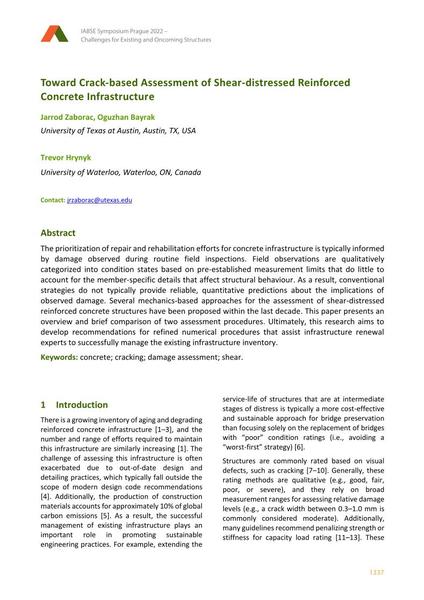Toward Crack-based Assessment of Shear-distressed Reinforced Concrete Infrastructure

|
|
|||||||||||
Détails bibliographiques
| Auteur(s): |
Jarrod Zaborac
(University of Texas at Austin, Austin, TX, USA)
Oguzhan Bayrak (University of Texas at Austin, Austin, TX, USA) Trevor Hrynyk (University of Waterloo, Waterloo, ON, Canada) |
||||
|---|---|---|---|---|---|
| Médium: | papier de conférence | ||||
| Langue(s): | anglais | ||||
| Conférence: | IABSE Symposium: Challenges for Existing and Oncoming Structures, Prague, Czech Republic, 25-27 May 2022 | ||||
| Publié dans: | IABSE Symposium Prague 2022 | ||||
|
|||||
| Page(s): | 1337-1344 | ||||
| Nombre total de pages (du PDF): | 8 | ||||
| DOI: | 10.2749/prague.2022.1337 | ||||
| Abstrait: |
The prioritization of repair and rehabilitation efforts for concrete infrastructure is typically informed by damage observed during routine field inspections. Field observations are qualitatively categorized into condition states based on pre-established measurement limits that do little to account for the member-specific details that affect structural behaviour. As a result, conventional strategies do not typically provide reliable, quantitative predictions about the implications of observed damage. Several mechanics-based approaches for the assessment of shear-distressed reinforced concrete structures have been proposed within the last decade. This paper presents an overview and brief comparison of two assessment procedures. Ultimately, this research aims to develop recommendations for refined numerical procedures that assist infrastructure renewal experts to successfully manage the existing infrastructure inventory. |
||||
| Mots-clé: |
béton
|
||||
| Copyright: | © 2022 International Association for Bridge and Structural Engineering (IABSE) | ||||
| License: | Cette oeuvre ne peut être utilisée sans la permission de l'auteur ou détenteur des droits. |
||||
